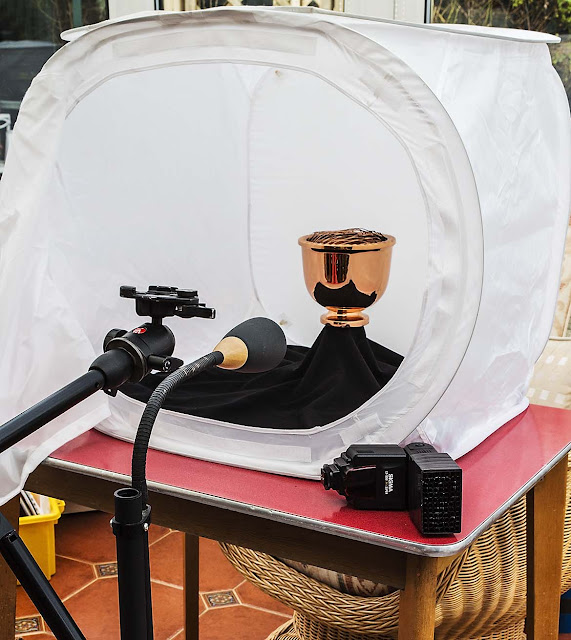The coursebook recommends making a light tent out of tracing paper, in the shape of a cone. Unfortunately I was unable to get hold of large sheets of tracing paper, however a friend had a light cube which I was able to use, included is a photograph of the set-up used.
"Take photographs with the light outside of the 'tent' in different positions and at different distances, also try changing the angle of the object slightly. Depending on the choice of objects, some difficulty may be had in losing the reflection of the camera lens."
Because the light cube had a slit in the front for the camera lens to go through, moving it to a position where a reflection of the lens in the object being photographed was not possible.
I tried three different objects for this exercise, the inside of a defunct computer hard drive, a chrome sweet dish and a copper rose bowl. A brief description of the lighting angle is with each image.
Flashgun inside tent alongside the camera.
Light through the side of the tent.
Light through the front of tent, under exposed.
The disc of the hard-drive was very reflective almost like a mirror and of course flat, this made it impossible to hide the reflection of the camera lens and of course the light when it was next to the camera. Even when the light was held at the same level as the disc, some reflection can still be seen although the shiny disc is now very dark because no light is now shining down on it.
Sweet dish with light to side of camera.
Light through the side.
Light from the top and front.
Again problems with reflections in the chrome dish, lighting from above shows the red sweets up well, this helps draw the eye away from the problems with the dish.
Copper rose bowl, flash to side of camera.
Light through top left of tent.
Light top centre of tent, slight reduction in output of flashgun.
Now that the exercise is finished, I'm wondering if using a cone of tracing paper might have worked better. The light tent was easy to work with, being light, made of neutral material with plenty of room to arrange the subject to be photographed. The last image, the one I consider to be the best, illustrates my point. I have managed to minimize the reflection of the camera and lens, however you can clearly see the shape of the light tent and black fabric the bowl was standing on, a cone of tracing paper would not have been so noticeable.










No comments:
Post a Comment